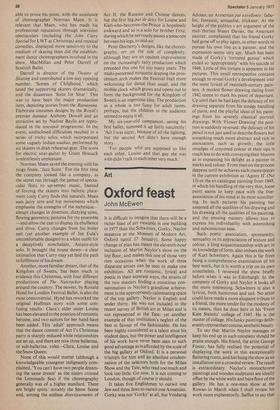Dance
Thin ice
Jan Murray
John Curry's Theatre of Skating (Cambridge)
The Nutcracker (Festival Hall) Some commentators have blamed John Curry's management for production errors which mar his Theatre of Skating,. the crude amplification of a concealed orchestra; unflattering costumes for the women; a cramped ice area, narrowing an already limited performing vocabulary; restricted sightlines even in some expensive seats; a running time of just over an hour, extended by lengthy intervals. Larry Parnes, who operates the Cambridge Theatre and presents this season, must expect brickbats for irritations suffered by the public. But the over-refined concept of the show and the choice of artistic collaborators are entirely the responsibility of the star.
Has Curry proved too subtle in this, his first attempt at extending the boundaries of skating ? Can 'ice dancing' ever rival the expressiveness of ballet and become a legitimate art form ? On the evidence of this debut programme, the answer must be a qualified no. It is qualified by Curry himself, for as a performer his every movement is so right, so innately musical, so seamlessly fluent, that he generates a very special kind of excitement. In a solo choreographed by the Royal Ballet's Kenneth MacMillan to Liszt's Feux-follets he moved with such effortless grace that momentarily it became possible to forget the heavy skates, the confined space. Even his tumble at the climax was redeemed by a charmingly sheepish curtain call (though not by a lighting technician who, in panic, simultaneously projected an advertisement for a restaurant on the backcloth).
Again, in a duet to Afternoon of a Faun with lissom Cathy Foulkes. Curry was
able to prove his point, with the assistance of choreographer Norman Maen. It is relevant that Maen, who has made his professional reputation through television spectaculars (including the John Curry Special for LWT at Christmas) and musical comedies, displayed more sensitivity to the medium of skating than did the establishment dance choreographers involved in the show, MacMillan and Peter Darrell of Scottish Ballet.
Darrell is director of the Theatre of Skating and contributed a low-key opening number, 'Scenes of Childhood,' which taxed the supporting skaters dramatically, and the disastrous 'Suite for Sitar.' This was to have been the major production item, depicting stories from the Ramayana. Elaborate costumes designs by the Royal's premier danseur Anthony Dowell and an attractive set by Nadine Baylis are reproduced in the souvenir programme. In the event, undisclosed difficulties resulted in a series of tricky solos which incorporated some vaguely Indian mudras, performed by six skaters in drab rehearsal gear. The score for electric sitar-guitar by Grant Hossack is relentlessly unpleasant.
Norman Maen saved the evening with his zingy finale, 'Jazz Suite.' For the first time the company looked like a company, as the septet ran through the gamut of spectacular feats to up-tempo music, Instead of forcing the skaters into balletic placement (only Curry finds this natural). Maen uses jazzy arm and hip movements which emphasise the strengths of the technique— abrupt changes in direction, dizzying spins, flowing geometric patterns for the ensemble —and allow the cast to display its ebullience and drive. Curry changes from his boiler suit (yet another example of Joe Eula's uncomfortable designs) to a white outfit for a deceptively nonchalant, Astaire-style solo. It brought the house down—a clear intimation that Curry may yet find the path to fulfilment of his dream.
Another, more familiar dream, that of the Kingdom of Sweets, has been much in evidence this Christmas, with four different productions of The Nutcracker playing around the country. The newest, by Ronald Hynd for London Festival Ballet, is also the most controversial. Hynd has reworked the original Hoffman story with some confusing results: Clara's elder sister Louise has been elevated to the position of romantic heroine, and two suitors for her hand have been added. This 'adult' approach means that the dance content of Act I's Christmas party is sharply reduced while relationships are set up, and there are now three ballerina, or sub-ballerina, roles—Clara, Louise and the Snow Queen.
None of this would matter (although a knowledgeable youngster indignantly complained, 'You can't have two people dreaming the same dream' as the sisters crossed the Lemonade Sea) if the choreography generally was of a higher standard. There are bright spots: notably the Snow Scene and, among the endless divertissements of
Act II, the Russian and Chinese dances, but the first big pas de deux for Louise and Karl-who-becomes-the-Prince is hopelessly awkward and so is a solo for brother Fritz, during which he nervously passes a telescope between his legs, in mid-air.
Peter Docherty's designs, like the choreography, err on the side of complexity, although they are an opulent improvement on the increasingly tatty production which preceded this one for too many years. The multi-patterned moquette draping the proscenium arch makes the Festival Hall more welcoming for dance than usual, and the mobile clock which grows and opens out to form the background for the Kingdom of Sweets is an ingenious idea. The production as a whole is too fussy for adult tastes, perhaps, but the children in the audience seemed to enjoy it all.
MY six-year-old companion, seeing his first ballet, summed it up fairly succinctly: 'Act 1 was super, because of all the fighting, but the second Act didn't have enough story.
'For people who are supposed to like each other, Louise and that guy she was with didn't talk to each other very much.'



































 Previous page
Previous page